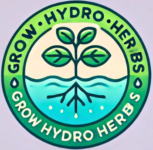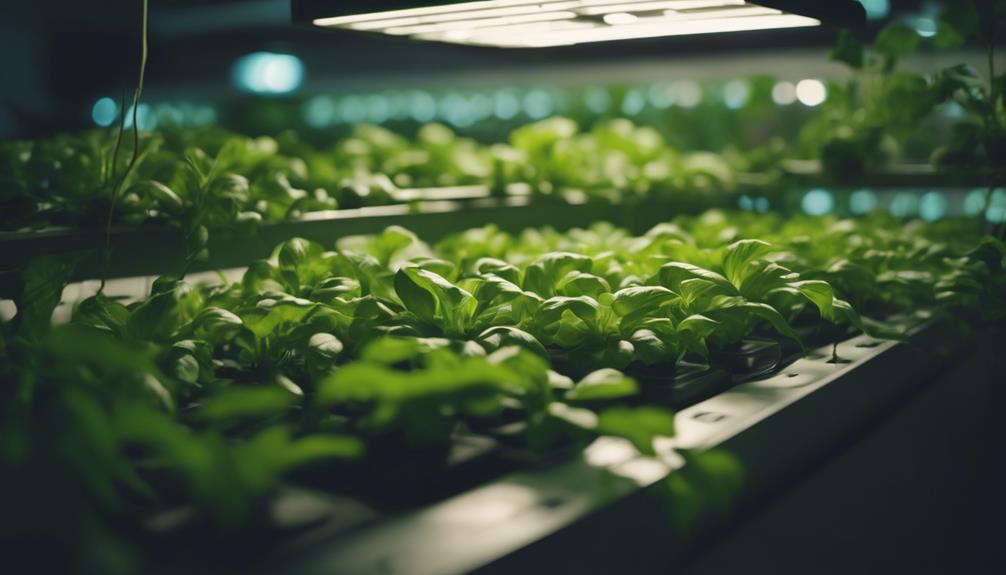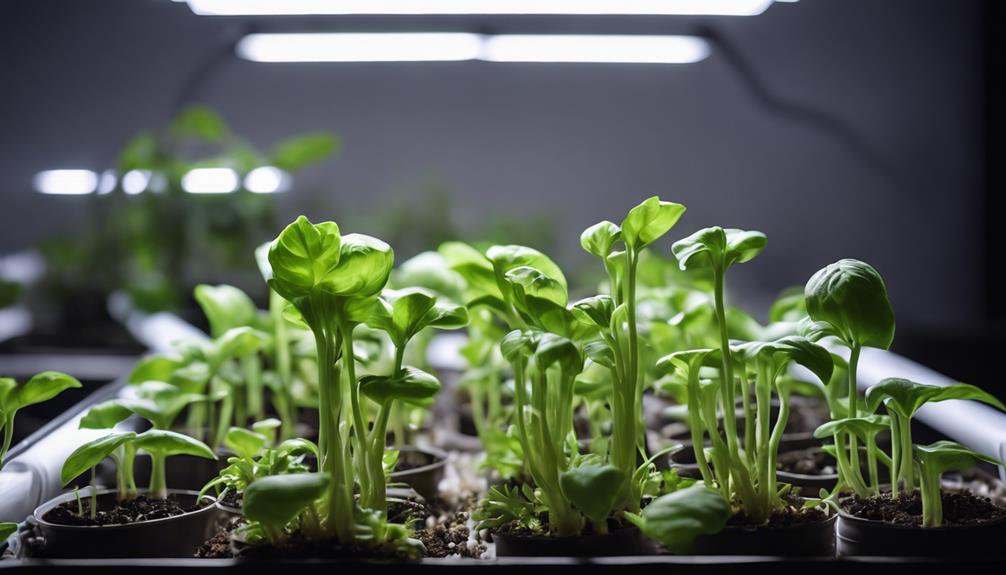How do you troubleshoot hydroponic grow lights?
If your hydroponic grow lights are giving you trouble, start by checking the power source for dimness or flickering. Adjust light intensity settings and consider replacing bulbs if needed. Keep lights from overheating by improving ventilation and controlling temperatures. Guarantee even light distribution by adjusting heights and adding reflective surfaces.
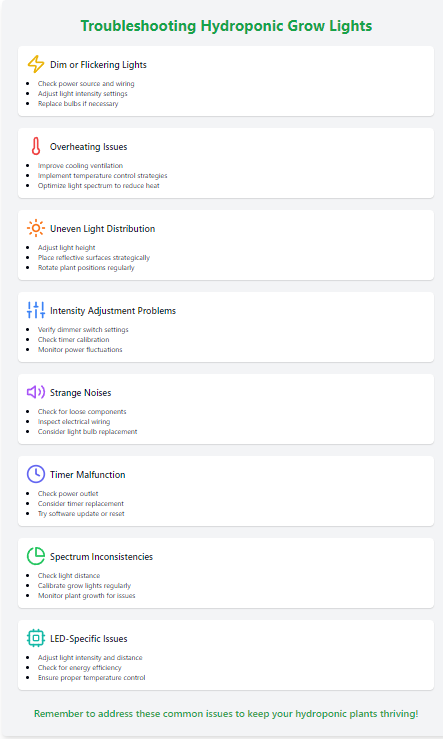
Confirm dimmer and timer settings for proper light intensity. Investigate strange noises and seek professional help if needed. Verify outlets and timers for malfunctions and maintain a consistent light spectrum for healthy plants. Address LED light issues promptly. More helpful tips await to fix your grow light problems.
GrowHydroHerbs TLDR
- Check power source and wiring for dim or flickering lights.
- Adjust light intensity settings for optimal growth.
- Ensure proper cooling and ventilation to prevent overheating.
- Position lights correctly for even light distribution.
- Regularly maintain and troubleshoot LED grow lights.
Dim or Flickering Lights?
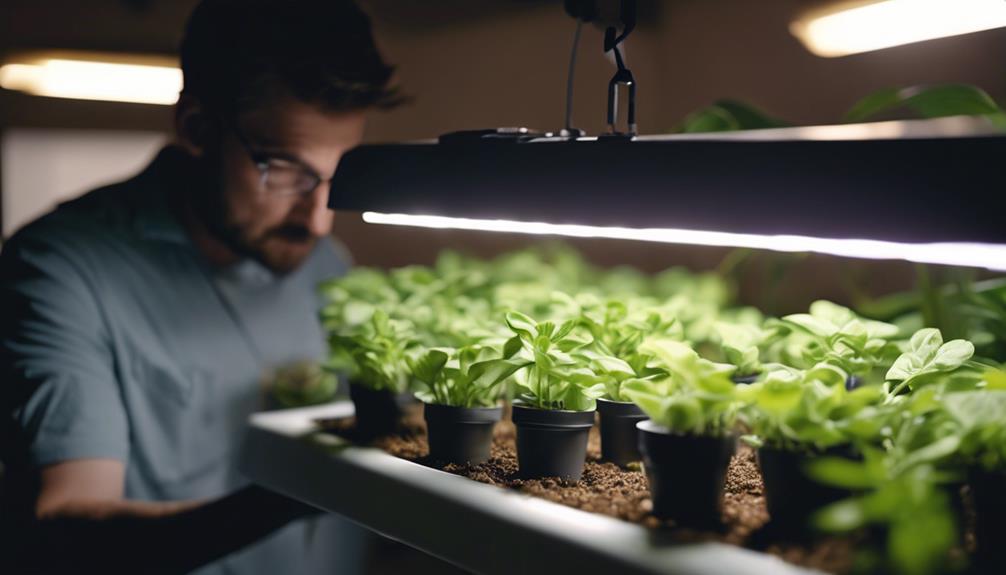
If your hydroponic grow lights appear dim or flicker, check the power source first. Dim or flickering lights can be caused by power source issues or electrical wiring problems.
Before verifying more complex solutions, make sure that the power supply to your grow lights is stable and not fluctuating. If the power supply is consistent, the next step would be to inspect the light intensity regulation settings. Sometimes, the lights may appear dim due to incorrect settings that need adjustment.
Another common reason for dim or flickering lights could be the need for bulb replacement. Over time, grow light bulbs can lose their efficiency and start to flicker or produce less light. If you notice this issue, try replacing the bulbs with new ones to see if it resolves the problem.
Overheating Issues?
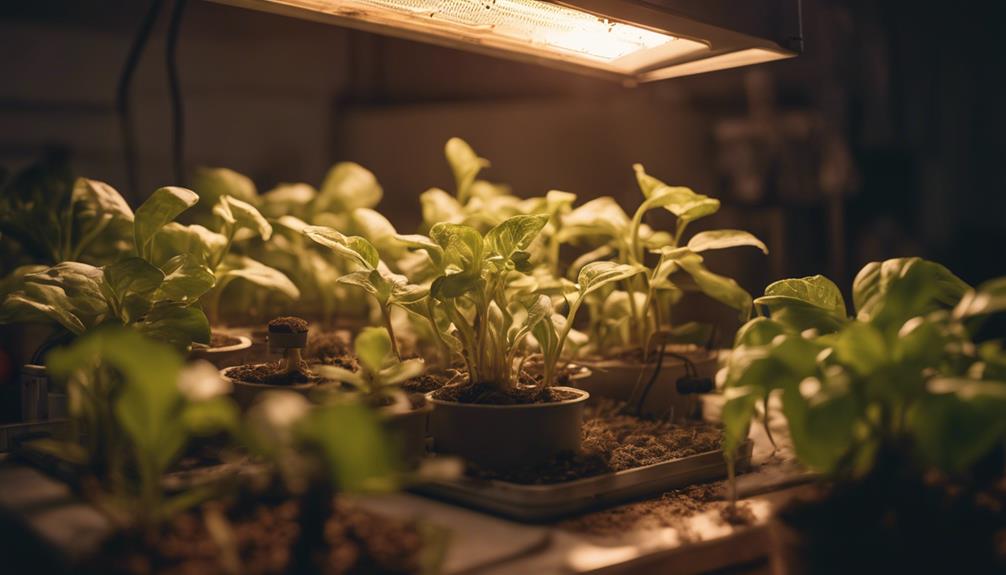
If your hydroponic grow lights are overheating, you need to address this issue promptly. Implementing cooling ventilation solutions can help maintain ideal temperatures for your plants.
Consider temperature control strategies to prevent overheating and guarantee the health of your plants.
Cooling Ventilation Solutions
Consider installing additional fans or an exhaust system to improve airflow and prevent overheating issues with your hydroponic grow lights. Proper air circulation is essential for maintaining ideal temperatures and preventing heat buildup.
When placing fans, make sure they’re strategically located to promote efficient heat dissipation. Fans should be positioned to create a consistent airflow throughout the grow space, helping regulate the temperature and prevent hot spots.
An exhaust system can also aid in removing excess heat from the grow area, especially in enclosed environments. By venting out warm air, the system contributes to temperature regulation and prevents overheating.
Combining fans with an exhaust setup can enhance overall cooling efficiency, creating a more favorable environment for your plants.
Temperature Control Strategies
Installing additional cooling equipment, such as fans and an exhaust system, can effectively address overheating issues with your hydroponic grow lights. When dealing with overheating problems, it’s vital to regulate the humidity levels in your grow space.
High humidity can worsen heat stress on your plants and hinder their growth. By optimizing the light spectrum of your grow lights, you can also help reduce excess heat production. Certain light spectrums can provide the necessary light intensity for plant growth stimulation while emitting less heat, thereby lowering the temperature in your grow area.
Moreover, keep an eye on the power consumption of your cooling equipment. Energy-efficient fans and exhaust systems can help maintain ideal temperatures without significantly increasing electricity costs. Balancing the cooling system’s effectiveness with its energy efficiency is key to managing overheating issues in a cost-effective manner.
Uneven Light Distribution?
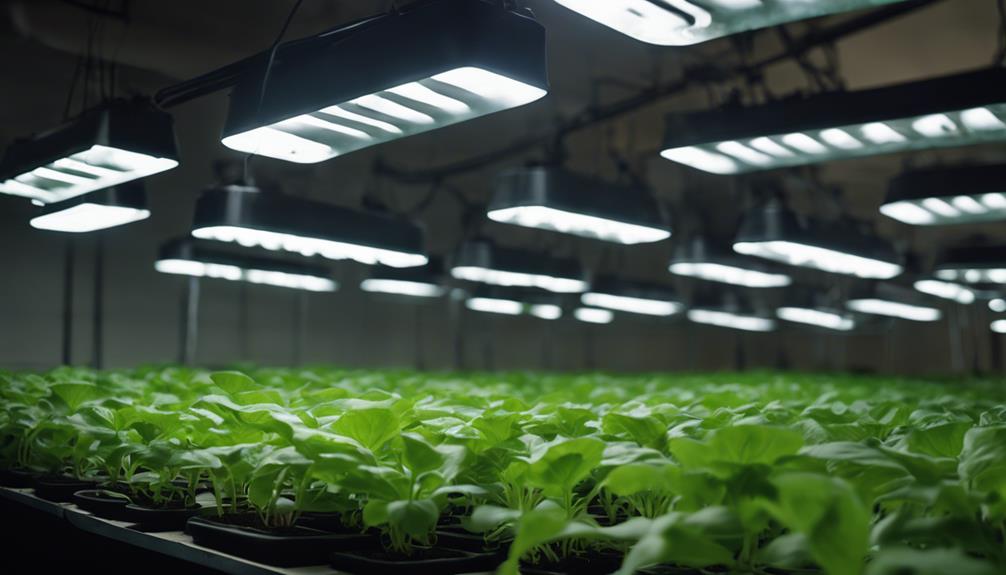
Adjust the height of your grow lights to guarantee an even distribution of light across your plants.
Place reflective surfaces strategically to maximize light reflection and reach all areas of your hydroponic system.
Remember to rotate your plant positions regularly to promote uniform light exposure and healthy growth.
Light Height Adjustment
To guarantee even light distribution in your hydroponic setup, make sure to regularly check and adjust the height of your grow lights as needed. Proper light height adjustment is essential for optimizing the light spectrum reaching your plants and promoting healthy plant growth.
When the grow lights are too close to the plants, they can cause light burn, stunting growth and affecting the overall health of your crops. On the other hand, if the lights are too far away, the light intensity may not be sufficient for proper photosynthesis, leading to leggy plants and reduced yields.
To make sure your plants receive the right amount of light, adjust the height of the grow lights according to the specific requirements of your plant species and growth stage. Monitor your plants regularly for any signs of light stress, such as yellowing or browning of leaves.
Reflective Surfaces Placement
Check that the placement of reflective surfaces in your hydroponic setup is effectively distributing light to all areas of your plants to prevent uneven light distribution issues.
For best results, consider the following:
- Light Reflection Angles: Confirm that the reflective surfaces are positioned at angles that bounce light evenly across your plants. Reflective materials like Mylar or white paint can help redirect light towards areas that might be receiving less illumination.
- Surface Coverage: Make sure that the reflective surfaces cover as much of the grow area as possible to maximize light reflection. This will help prevent shadows and dark spots that can hinder plant growth. Reflective materials such as aluminum foil or reflective films can be used to increase coverage and enhance light distribution.
- Reflective Material Types, Benefits: Experiment with different types of reflective materials to see which works best for your setup. Each material has its benefits, such as durability, heat resistance, and light-reflecting properties. Choose a material that suits your needs and helps maintain consistent light distribution throughout your hydroponic system.
Rotating Plant Position
Consider rotating your plants regularly to promote even light distribution and prevent certain areas from receiving more light than others, leading to potential growth issues. By rotating your plants, you guarantee that each side of the plant receives an equal amount of light exposure, promoting balanced growth and preventing issues caused by uneven light distribution.
| Benefits of Rotating Plant Position |
|---|
| 1. Promotes Even Light Distribution |
| 2. Prevents Unequal Light Exposure |
| 3. Enhances Overall Plant Growth |
Rotating your plants helps prevent situations where one side of the plant receives more light than the other. Uneven light exposure can lead to stunted growth on one side of the plant, affecting its overall health and productivity. By regularly rotating your plants, you make sure that all sides receive adequate light, promoting symmetrical growth and maximizing the plant’s potential. Keep an eye on the light direction in your growing area and adjust the plant positions accordingly to optimize their exposure and support their overall development.
Intensity Adjustment Problems?
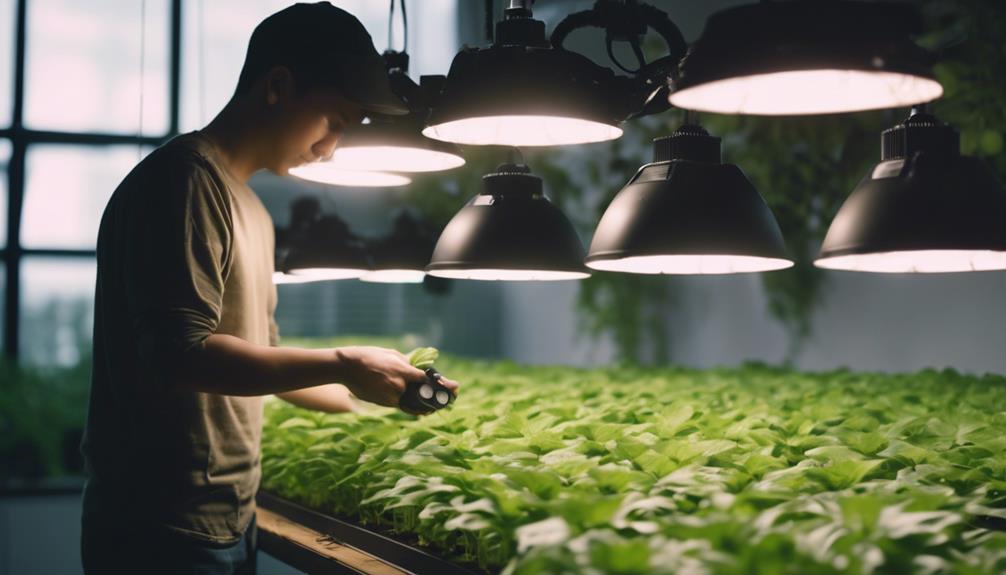
If your hydroponic grow lights are experiencing intensity adjustment problems, start by confirming that the dimmer switch is set to the correct level. Here are some tips to help you troubleshoot and resolve these issues:
- Check Timer Calibration: Verify that the timer for your grow lights is accurately calibrated. Incorrect timer settings can affect the intensity of the light received by your plants, leading to growth issues.
- Monitor Power Fluctuations: Fluctuations in power supply can impact the brightness levels of your grow lights. Use a surge protector or stabilizer to regulate the power and maintain consistent light intensity.
- Adjust Brightness Levels: Experiment with different brightness levels on your grow lights to find the best setting for your plants. Different stages of plant growth may require varying light intensities to thrive effectively.
Hearing Strange Noises From Lights?

Experiencing strange noises coming from your hydroponic grow lights can indicate potential issues that need to be addressed promptly. If you hear buzzing, crackling, or humming sounds, it’s important to investigate the source to guarantee the safety and efficiency of your setup.
Start by checking if the noises are coming from the bulbs themselves. Sometimes, a buzzing sound could mean it’s time for a light bulb replacement. Make sure the bulbs are securely screwed in and not flickering, as this could also cause unusual sounds.
Another significant step is to inspect the electrical wiring connected to your grow lights. Loose or faulty wiring can lead to electrical noises and pose a fire hazard. It’s advisable to turn off the lights and unplug them before examining the wiring for any signs of damage or wear.
To reduce or eliminate the noises, regular light fixture maintenance is key. Tighten any loose components, clean out dust or debris that may be causing vibrations, and ensure the fixtures are securely mounted.
Do you have a Timer Malfunction?
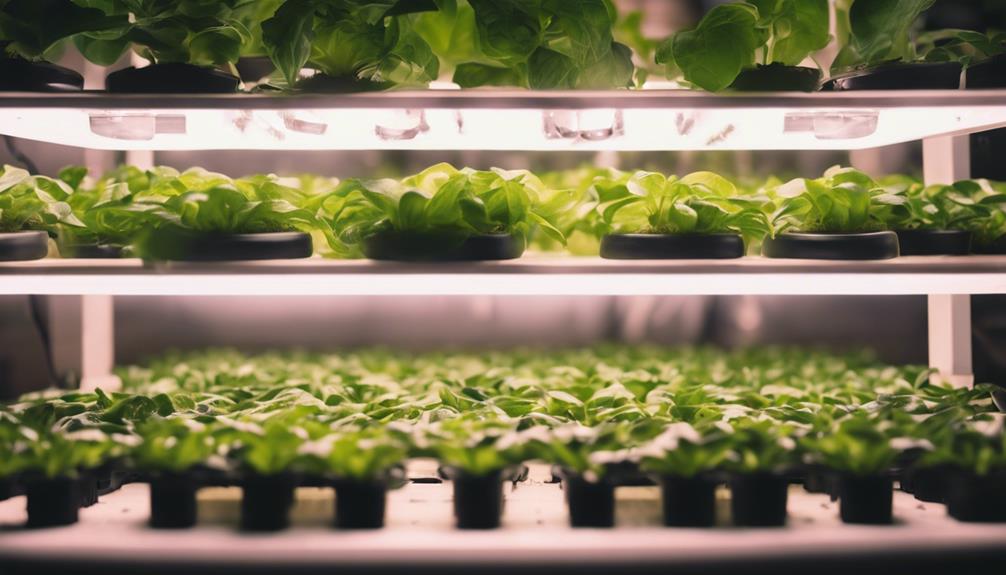
Detecting timer malfunctions in your hydroponic grow lights is crucial for maintaining a consistent lighting schedule for your plants. Here are three steps to help you troubleshoot timer issues:
- Check for Power Outlet Problems: Guarantee that the power outlet you’re using is functioning correctly. Sometimes, a faulty outlet can cause the timer to malfunction. Try plugging the timer into a different outlet to see if the issue persists.
- Consider Timer Replacement: If you have ruled out power outlet problems and the timer is still not working properly, it may be time to replace the timer. Look for a timer that’s compatible with your grow lights and follow the manufacturer’s instructions for installation.
- Try a Software Update or Timer Reset: Some timers may require a software update to fix bugs or glitches. Check the manufacturer’s website for any available updates. Alternatively, you can try resetting the timer according to the instructions provided to see if that resolves the malfunction.
Do you have Spectrum Inconsistencies?
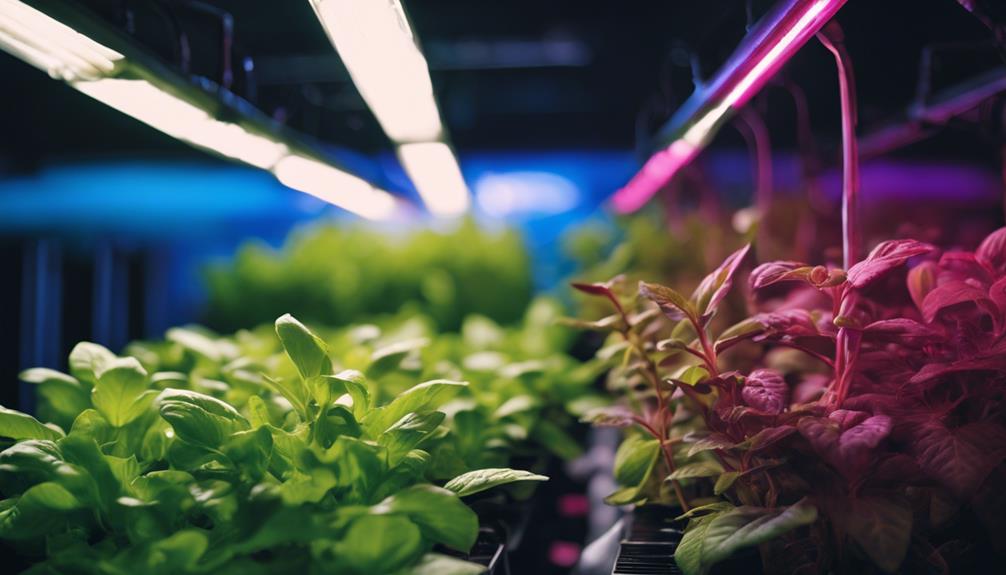
Consistency in the spectrum of light emitted by your hydroponic grow lights is essential for top plant growth and development. Spectrum calibration guarantees that your plants receive the best light spectrum necessary for photosynthesis and overall health. Inconsistencies in the light spectrum can lead to stunted growth, poor flowering, or even plant death.
To address spectrum inconsistencies, start by checking the light distance from your plants. Improper distance can cause variations in the light spectrum reaching your plants, impacting their growth. Adjust the height of your grow lights to maintain a uniform spectrum across all plants.
Regularly calibrating your grow lights is also crucial to ensure a consistent light spectrum. Over time, lights can shift in their spectrum output, affecting plant growth. Follow the manufacturer’s guidelines on spectrum calibration to maintain an ideal light spectrum for your plants.
Troubleshoot Hydroponic Grow Lights: LEDs
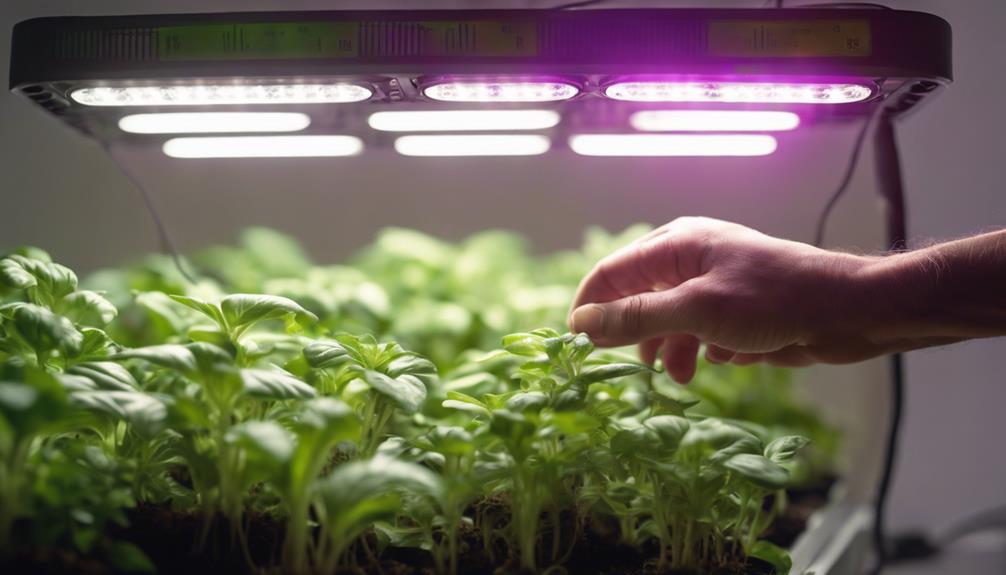
To troubleshoot LED grow lights effectively, make sure you address any potential issues affecting their performance to maintain peak plant growth. Here are three essential aspects to take into account when troubleshooting LED grow lights:
- Light intensity: Insufficient light intensity can hinder plant growth. Check if the lights are positioned at the correct distance from the plants. LED grow lights have specific recommended hanging heights depending on the plant’s growth stage. Adjust the height accordingly to guarantee ideal light exposure for your plants.
- Energy efficiency: LED grow lights are known for their energy efficiency; however, if you notice a sudden increase in energy consumption or a significant decrease in light output, there may be an issue. Check for any loose connections or damaged components that could be causing the inefficiency. Regularly clean the lights to prevent dust buildup, which can reduce their effectiveness over time.
- Temperature control: LED grow lights emit heat, and excessive heat can damage both the lights and the plants. Ensure proper ventilation and cooling systems are in place to maintain the ideal temperature for your grow room. Monitor the temperature regularly to prevent any issues related to overheating.
Troubleshooting Hydroponic Grow Lights: What to do?
Overall, troubleshooting hydroponic grow lights can be a simple process if you follow these steps. Remember to check for:
- Dim or flickering lights
- Overheating issues
- Uneven light distribution
- Intensity adjustment problems
- Strange noises
- Timer malfunctions
- Spectrum inconsistencies
By addressing these common problems, you can guarantee that your plants receive the best light they need to thrive in your hydroponic system.
Happy growing!
